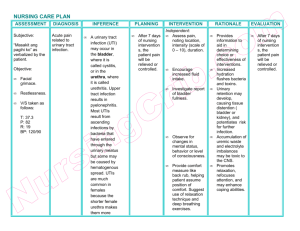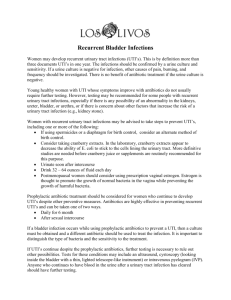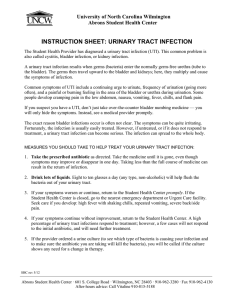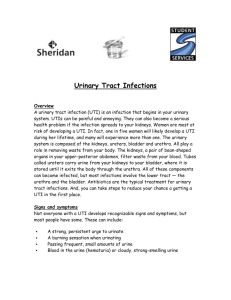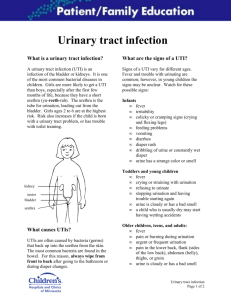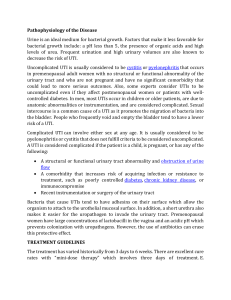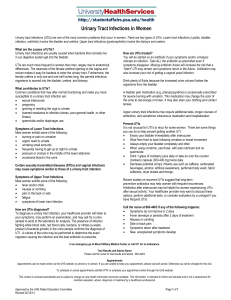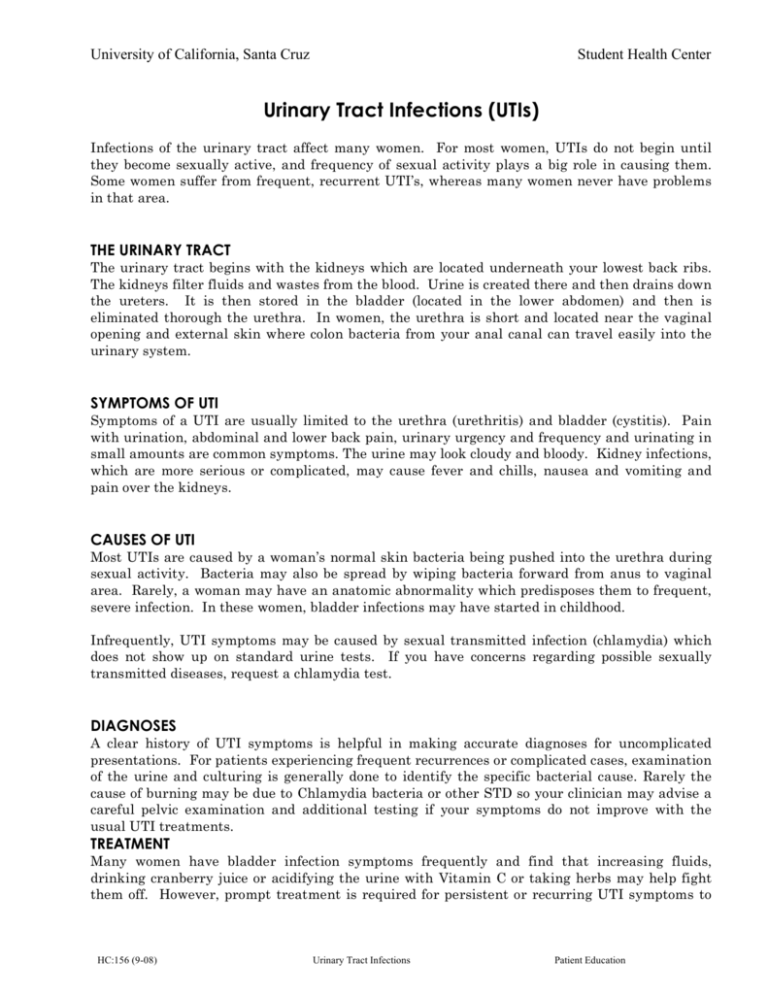
University of California, Santa Cruz
Student Health Center
Urinary Tract Infections (UTIs)
Infections of the urinary tract affect many women. For most women, UTIs do not begin until
they become sexually active, and frequency of sexual activity plays a big role in causing them.
Some women suffer from frequent, recurrent UTI’s, whereas many women never have problems
in that area.
THE URINARY TRACT
The urinary tract begins with the kidneys which are located underneath your lowest back ribs.
The kidneys filter fluids and wastes from the blood. Urine is created there and then drains down
the ureters. It is then stored in the bladder (located in the lower abdomen) and then is
eliminated thorough the urethra. In women, the urethra is short and located near the vaginal
opening and external skin where colon bacteria from your anal canal can travel easily into the
urinary system.
SYMPTOMS OF UTI
Symptoms of a UTI are usually limited to the urethra (urethritis) and bladder (cystitis). Pain
with urination, abdominal and lower back pain, urinary urgency and frequency and urinating in
small amounts are common symptoms. The urine may look cloudy and bloody. Kidney infections,
which are more serious or complicated, may cause fever and chills, nausea and vomiting and
pain over the kidneys.
CAUSES OF UTI
Most UTIs are caused by a woman’s normal skin bacteria being pushed into the urethra during
sexual activity. Bacteria may also be spread by wiping bacteria forward from anus to vaginal
area. Rarely, a woman may have an anatomic abnormality which predisposes them to frequent,
severe infection. In these women, bladder infections may have started in childhood.
Infrequently, UTI symptoms may be caused by sexual transmitted infection (chlamydia) which
does not show up on standard urine tests. If you have concerns regarding possible sexually
transmitted diseases, request a chlamydia test.
DIAGNOSES
A clear history of UTI symptoms is helpful in making accurate diagnoses for uncomplicated
presentations. For patients experiencing frequent recurrences or complicated cases, examination
of the urine and culturing is generally done to identify the specific bacterial cause. Rarely the
cause of burning may be due to Chlamydia bacteria or other STD so your clinician may advise a
careful pelvic examination and additional testing if your symptoms do not improve with the
usual UTI treatments.
TREATMENT
Many women have bladder infection symptoms frequently and find that increasing fluids,
drinking cranberry juice or acidifying the urine with Vitamin C or taking herbs may help fight
them off. However, prompt treatment is required for persistent or recurring UTI symptoms to
HC:156 (9-08)
Urinary Tract Infections
Patient Education
University of California, Santa Cruz
Student Health Center
avoid the risk of the infection progressing to a more serious kidney infection. Simple bladder
infections caught early can be treated with a few days of antibiotics whereas a kidney infection
can require long term antibiotics and even hospitalization. Symptoms should be gone within 3
days. There is a bladder anesthetic (pyridium or uristat) that can help the pain until the
antibiotics became effective. Avoidance of caffeine, alcohol, spicy foods and carbonated beverages
can also decrease the discomfort of infection and aid in healing.
When you are given an antibiotic, a particular medication is chosen that has a high probability of
killing the offending organism, without causing you undue physical or financial hardship. It is
important to realize that the specific medication you are given may not kill the bacteria you are
harboring. If you are not getting better, or are clearly worse in a day or two, it is critical that you
come back or contact us right away. Allergic reactions to medication are not uncommon. If you
break out in a rash or have other new symptoms, again, we want to know about it. Some
antibiotics are not safe in early pregnancy. Please let us know if there is any chance
you could be pregnant before taking any medicines. One minor, yet annoying side effect of
antibiotic use is the development of a vaginal yeast infection. This is less common when we are
able to use a short course (3 day) prescription. If you do develop vaginal itching and a clumpy
discharge, you may want to treat yourself with an over the counter anti-yeast preparation,
available at our and other pharmacies. If you are uncertain what is going on, we encourage you
to return for a follow-up visit.
PREVENTION
Develop the habit of drinking plenty of water daily.
Use mild body soap only.
Extra lubrication may be needed during intercourse. Various products are available
You may need to decrease the frequency and duration of sexual encounters.
Practice Safer Sex (use condoms and other barrier methods).
Urinate before and after sex.
Wipe from front to back after going to the bathroom
Avoid thong underwear and tight clothes
COMPLICATIONS
If new symptoms develop, if you are not better within 2-3 days, or if you have side effects from
the medication, please contact the Health Center.
HC:156 (9-08)
Urinary Tract Infections
Patient Education

